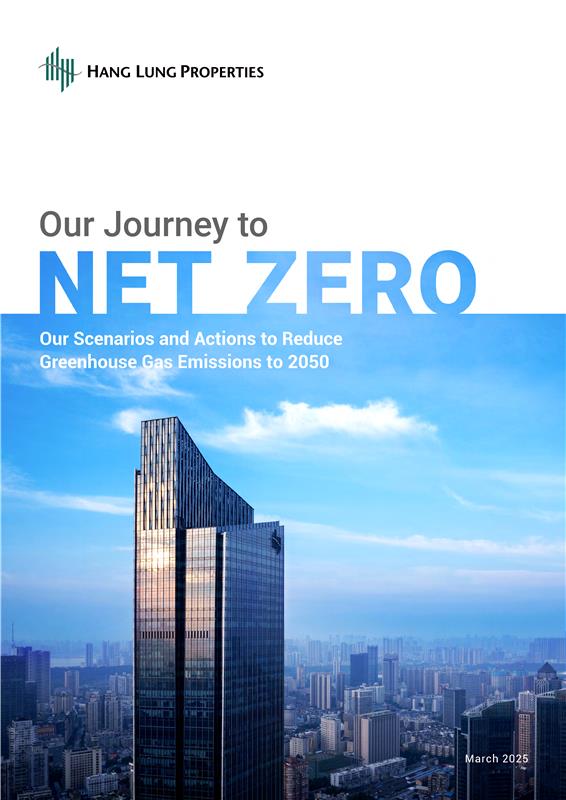We aim to sustain a healthy, inclusive and safe environment for our employees and customers as well as promote wellbeing in our communities. Wellbeing is a broad concept which includes not only health and safety but also other positive attributes such as a sense of belonging, sense of security, adequate nourishment, peace of mind, feeling connected to the natural world, etc. We will strive to improve the wellbeing of our employees, customers and community members with careful attention to established and emerging international best practices in this domain.
2030 Goal
Ensure employees, customers and communities enjoy an unrivalled environment that promotes their health and wellbeing.
2030 Targets
- Assess wellbeing for all employees and key customers
- Meet or exceed wellbeing standards for new properties
- Work with youth on sustainability solutions in all cities where we have assets
25 x 25 Sustainability Targets
- Achieve an employee engagement rating greater than or equal to the 75th percentile
- Maintain Female-to-Male pay ratio of 1:1
- Conduct an audit of all our properties and corporate practices on how to enhance wellbeing and opportunities for persons with disabilities
- Obtain local or international health and wellness certification for all our existing Mainland properties
- Obtain WELL Gold certificate or equivalent for at least one new property in Hong Kong and mainland China
- Deliver priority ESG training targeted to all departments and seniority levels
- Maintain a Lost Time Injury Rate of 1.5 or below for employees
- Maintain zero work-related fatalities for employees and contractors
- Work with youth on wellbeing community initiatives at all properties by 2025
Employee Wellbeing
Recognizing that employee wellbeing can influence business performance significantly, we invest considerable resources to build a positive corporate culture, facilitate employees' career and personal growth, and promote work-life balance among our workforce. Measures we have implemented to enhance employee wellbeing include and are not limited to:
- Our Total Reward strategy aims to recognize and reward employees for their contributions by encompassing elements like salary, bonuses, benefits, recognition programs, career development, and work-life balance initiatives.
- Provide competitive compensation and benefits packages, including parental and family care leave, life, medical and dental insurance, and various corporate staff discounts;
- Regularly benchmark compensation against the market and ensure our pay-for-performance philosophy rewards employees fairly based on their contributions, and monitor the gender pay ratio in consideration of our target to uphold our commitment to equal remuneration;
- Has a transparent and standardized working hours with clear overtime arrangement processes ensuring proper wellbeing of employees;
- Grant paid annual leave entitlements with clear carry-forward rules to support rest and recovery;
- Deliver diversified training and development opportunities that cover professional skills, leadership, and emerging areas such as ESG regulations, artificial intelligence, and climate transition, enabling our employees to stay resilient and well-prepared for industry transformation;
- Maintain a safe workplace through our Health and Safety Policy and implement necessary preventive and mitigation measures for identified safety hazards;
- Promote a healthy lifestyle for our employees under the Employee Wellness Program;
- Implement a performance management framework that evaluates performance by means of objectives management, multidimensional feedback, team-based and individual evaluations, and agile conversations, etc. to support individual and team development. Our performance management is a continuous process that includes semiannual appraisals and ongoing dialogue to ensure alignment with strategic goals and employee behavior;
- Conduct employee engagement survey to identify means to enhance employee wellbeing. This survey evaluates key dimensions of employee engagement, including job satisfaction, emotional wellbeing, sense of purpose, work-life balance and potential stress-related issues
Customer Wellbeing
We foster the health and wellbeing of our building occupants through a wide range of building features and management practices. To safeguard the health of our tenants and their customers, we completed the upgrade of our air filtration system in all our properties in mainland China in 2019 under our Clean Air Initiative. In Hong Kong, we obtained the Indoor Air Quality (IAQ) Certificates issued by the Environmental Protection Department for those properties with medical tenants, to demonstrate our commitment to their expectation of a healthy space for their business operations.
We have obtained WELL HSR across our portfolio and WELL Gold and Platinum in selected properties.
The WELL Building Standard from the International WELL Building Institute (IWBI) is grounded in scientific principles and aims to cultivate environments—both physical and social—that support the health, wellbeing, and productivity of occupants. It includes over 100 features across ten categories, such as indoor environmental quality, water quality, thermal comfort, and workplace conditions.
For instance, to promote healthy eating habits, we introduced a healthy food vending machine at 228 Electric Road to provide tenants with convenient access to nutritious food options. When we host events for our tenants, including, for instance, events in Plaza 66 in 2023 and 2024, healthy food is a consideration the caterer selection and menu.
We also maintain visual, acoustic, and thermal comfort to improve occupant experience through optimal daylight exposure in building designs, acoustic provisions and temperature monitoring.
Community Wellbeing
Other than giving back to society by means of our community investment, we recognize that cultural conservation is vital for sustainability. We aim to strike a balance between conserving local heritage and adding vibrancy to local communities. We have carefully considered the planning, building and operations of our developments by restoring, preserving and integrating historical buildings into our project designs wherever possible. In recent years we conserved several historical buildings, please click here for more details.
Human Rights
We strive to uphold the dignity, freedom, and rights of all individuals and take reference from internationally recognized human rights principles, including the United Nations Universal Declaration of Human Rights, the International Labour Organization (ILO) Declaration on Fundamental Principles and Rights at Work, the United Nations Guiding Principles on Business and Human Rights, and relevant local laws and regulations. As a signatory of the United Nations Global Compact, we are committed to supporting and respecting the protection of internationally proclaimed human rights and to ensuring that our operations are not complicit in abuses.
In the context of our business, we strive to uphold human rights by identifying, assessing and managing risks that could compromise the dignity, freedom, and rights of individuals across four thematic areas: labor rights, occupational health and safety, digital rights, and anti-corruption. Our risk mapping of potential issues is reviewed at least annually through our Sustainability Steering Committee. Below we describe some of the key risks, mitigation measures and forms of assessment we undertake in each of these four areas with respect to our operations and our contractors and Tier-1 suppliers.
Anti-corruption
- Risks include bribery, conflicts of interest, and unethical behavior.
- Mitigation Measures: We have policies and procedures in place requiring all employees to complete annual integrity training and annual declaration of interests, conduct due diligence on third parties, maintaining transparent financial records. We also provide secure whistleblowing channels with protection against retaliation. We also set expectations for suppliers and contractors through our Code of Conduct for Suppliers and Contractors.
- Assessments: Our internal and external auditors regularly conduct assessments across our business to assess the effectiveness of control environment and systems of internal control. Our senior management periodically reviews fraud and corruption risks under the Group’s established Enterprise Risk Management framework, ensures adequate controls are in place, and reports material breaches (if any) to the Board / Audit Committee. In 2024, we assessed the compliance and conduct of 82% of our Tier-1 significant suppliers on business ethics matters through their self-reporting on platforms provided by Sedex and EcoVadis.
Digital rights
- Risks include unauthorized access to and usage / handling of personal data, excessive collection of information, and data breaches.
- Mitigation Measures: We mitigate these by applying stringent access controls, limiting data collection to what is necessary, training employees on data protection responsibilities, and operating incident response procedures, including escalation to regulators when required.
- Assessment: Our Data Security Management Committee (DSMC) serves as the governing body responsible for comprehensive data security (including personal information) management and governance, and reports to the CEO regularly. This committee promotes a proactive approach to personal privacy protection through risk assessment conducted across the Group. We also engage external security professionals with appropriate credentials to conduct third party audits at least annually and assess our readiness through regular vulnerability analysis and attack scenarios, including simulated hacker attacks.
Labor rights
- Risks include discrimination, harassment, child and forced labor, inadequate leave entitlements, and excessive overtime, etc.
- Mitigation Measures: We have policies and procedures in place that uphold equal opportunity in hiring and pay and maintain safe grievance channels, supported by training and engagement. We also set expectations for suppliers and contractors related to the prohibition of child or involuntary labor, discrimination, association and compensation, meal break, and rest time through our Code of Conduct for Suppliers and Contractors.
- Assessments: Regarding our employees, we have established a target to maintain a 1:1 female-to-male gender pay ratio and report on our performance against this target on an annual basis. We also report annually on our parental leave. We promptly and thoroughly investigate complaints of unlawful discrimination or harassment, with defined protocols for determining potential actions at the conclusion of the investigation. Lastly, in 2024, we assessed the compliance and conduct of 82% of our Tier-1 significant suppliers on labor matters through their self-reporting on platforms provided by Sedex and EcoVadis.
Occupational health and safety
Risks include workplace accidents, unsafe contractor practices at our sites, and emergency and crisis events, etc.
- Mitigation Measures: We have KPIs, targets and management systems to reduce risks and foster continual improvement in employee wellbeing, health and safety. We conduct regular compulsory health and safety training for all employees and implement periodic audits to ensure the effectiveness of our management systems across our entire portfolio. We also undertake regular risk assessments, deliver role-specific training, provide protective equipment, and conduct regular emergency drills. We also set health and safety expectations for suppliers and contractors through our Code of Conduct for Suppliers and Contractors.
- Assessments: We maintain a Group-level Health and Safety Subcommittee and a departmental-level safety committee for the property management function for regular review of the Group's safety performance. We have assembled a dedicated team of safe production management personnel responsible for overseeing safety management in our business operations. Their work includes conducting safety inspections, safety audits, safety training, participating in safety incident investigations, and implementing safe production supervision and guidance. On construction sites, we appoint independent safety consultants to monitor contractor performance on all projects, reported back to management through regular meetings. In 2024, we assessed the compliance and conduct of 82% of our Tier-1 significant suppliers on health and safety matters through their self-reporting on platforms provided by Sedex and EcoVadis.
The risk mitigation and assessment measures discussed above apply across our operations. Three of the four areas – anti-corruption, occupational health and safety and digital rights – are enterprise-level risks overseen by our Enterprise Risk Management framework. These risks are assessed and reviewed at least annually by the ERM Working Group, led by the CEO. And in three of the four areas we conducted assessments for 82% of our Tier-1 significant suppliers in 2024 – namely, anti-corruption, occupational health and safety, and labor rights.
No significant human rights violations have been identified in the last three years. We have processes in place to promptly address any concerns that arise, ensuring that issues are resolved in a fair and transparent manner. At the same time, we are committed to continual improvement in our risk mitigation measures and assessments, including for both existing and new business relationships. In our operations, we will continue to embed preventive planning and regular monitoring into our operations to strengthen our human rights safeguards over time. For suppliers, we recognize the value of leveraging supplier ESG platforms to conduct supplier screening while also acknowledging that our assessment process for suppliers will continue to evolve. We have worked with Sedex on initial pilots of on-site audits for selected suppliers and are examining where we may want to expand the scope of such audits. We also conduct training for suppliers to highlight significant risks, including human rights risks, and to build their capacity in risk controls. We will work to improve our supplier oversight through the development and expansion of our supplier ESG program in the coming years.





.png)